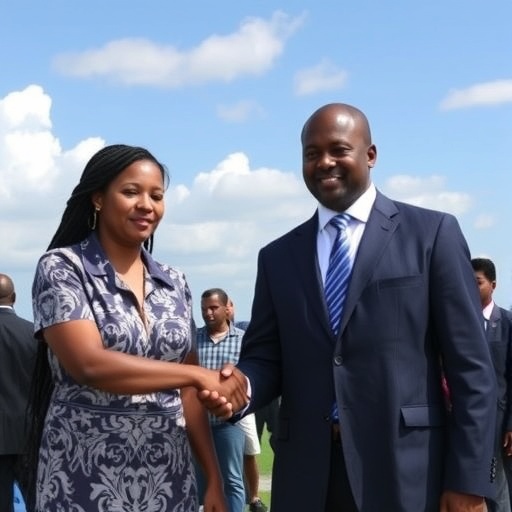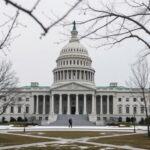Belize Signs Safe Third Country Agreement with U.S. Amid Trump’s Immigration Crackdown: What It Means for Asylum Seekers
In a surprising geopolitical pivot, Belize has inked a ‘safe third country’ agreement with the United States, aligning itself with President Donald Trump’s aggressive immigration policies just as border enforcement intensifies. This deal, announced late last week, positions the small Central American nation as a key partner in curbing irregular migration flows, potentially redirecting thousands of asylum seekers away from U.S. soil. Critics, however, warn that the pact could strain Belize‘s modest resources and undermine its sovereignty in handling asylum claims.
- Belize Steps into the Spotlight of U.S. Immigration Enforcement
- Trump’s Safe Third Country Push Targets Central American Migration Routes
- Belizean Sovereignty and Asylum System Face Unprecedented Strain
- Economic Incentives and Diplomatic Ties Drive the Deal
- Future Challenges: Legal Battles and Regional Ripple Effects
Belize Steps into the Spotlight of U.S. Immigration Enforcement
Belize, a nation of just over 400,000 people nestled between Mexico and Guatemala, has long been overshadowed in regional migration discussions. But the recent signing of the safe third country agreement catapults it into the forefront of U.S. immigration strategy. Under the terms of the deal, migrants arriving at the U.S. southern border who have passed through Belize will be ineligible for asylum processing in the United States and instead returned to Belize for adjudication. This mirrors existing pacts like the U.S.-Canada agreement but marks a significant expansion into Central America amid Trump’s crackdown.
President Trump hailed the agreement as a ‘game-changer’ during a White House briefing, stating, ‘Belize is proving that our neighbors understand the need to secure our borders together. No more free rides for those gaming the system.’ The announcement comes at a time when U.S. Customs and Border Protection reported over 2.5 million migrant encounters at the southwest border in fiscal year 2023, with a notable uptick from Central American routes. For Belize, the deal includes U.S. aid packages totaling $50 million annually, aimed at bolstering border security and asylum infrastructure.
Historically, Belize has managed a steady but manageable influx of migrants, with UNHCR data indicating around 5,000 asylum applications processed in 2022 alone. The agreement, however, could multiply this figure exponentially, as U.S. officials estimate up to 10,000 returns per year initially. Local experts like Dr. Elena Ramirez, a migration policy analyst at the University of Belize, expressed cautious optimism: ‘This could modernize our asylum system, but only if the funding translates to real capacity building. Otherwise, it’s a recipe for overload.’
Trump’s Safe Third Country Push Targets Central American Migration Routes
President Trump’s immigration agenda has always emphasized multilateral agreements to offload asylum responsibilities, and Belize’s commitment fits seamlessly into this framework. Since taking office, Trump has revived and expanded safe third country designations, building on policies from his first term that designated countries like Guatemala and Honduras. The Belize pact is the latest in a series of deals aimed at creating a ‘regional shield’ against what the administration calls ‘asylum abuse.’
Key provisions of the agreement require Belize to establish expedited asylum hearings within 30 days of a migrant’s return, with U.S. technical assistance in training judges and interpreters. In exchange, the U.S. pledges not to return migrants to their countries of origin without Belize’s approval, theoretically protecting against refoulement under international law. Statistics from the Department of Homeland Security show that safe third country protocols have already reduced asylum claims by 40% in partnered nations, a trend Trump hopes to replicate here.
Yet, the immigration landscape in Central America is complex. Belize shares a porous border with Guatemala, through which many migrants transit en route to Mexico and the U.S. The agreement includes joint patrols and intelligence sharing, with U.S. funding for surveillance tech like drones and biometric scanners. Immigration advocates, however, decry it as outsourcing America’s moral obligations. Maria Gonzalez, director of the Belize Refugee Council, noted, ‘Trump’s crackdown is pushing vulnerable people into limbo. Asylum isn’t a game; it’s a lifeline for those fleeing violence.’
To understand the broader context, consider the surge in migration drivers: gang violence in Honduras and El Salvador, political instability in Nicaragua, and economic despair exacerbated by climate change. Belize, with its English-speaking population and stable democracy, was seen as an ideal partner. The U.S. State Department highlighted Belize’s ‘proven track record’ in refugee resettlement, citing its hosting of over 20,000 Venezuelan migrants since 2019 without major incidents.
Belizean Sovereignty and Asylum System Face Unprecedented Strain
While the safe third country agreement promises economic boosts, it raises profound questions about Belize’s ability to sustain an expanded asylum role. Belize’s current asylum framework, governed by the 2006 Refugees Act, processes claims through a small tribunal with limited resources—handling fewer than 100 decisions per month on average. The influx from U.S. returns could overwhelm this system, leading to backlogs that stretch into years.
Government officials in Belmopan downplay the risks, pointing to the aid infusion as a lifeline. Prime Minister Johnny Briceño emphasized in a national address, ‘This partnership with the U.S. will enhance our security and economy without compromising our humanitarian values.’ The $50 million package breaks down into $20 million for judicial training, $15 million for detention facilities, and $15 million for community integration programs. Economically, it could create jobs in border regions, where unemployment hovers at 10%.
However, human rights groups are sounding alarms. Amnesty International’s Central America director, Luis Herrera, warned that ‘Belize lacks the infrastructure to fairly assess thousands of complex asylum cases. This could lead to wrongful deportations and violations of non-refoulement principles.’ A 2023 Human Rights Watch report already flagged delays in Belize’s asylum process, with 60% of applicants waiting over six months for initial interviews. Under the new deal, failure to meet processing timelines could trigger U.S. penalties, including aid cuts—ironic given the funding dependency.
Local communities are divided. In Belize City, where many migrants settle, residents express mixed feelings. Fisherman Carlos Mendoza shared, ‘More people mean more business, but also more strain on schools and hospitals.’ Indigenous groups in the Toledo District, near the Guatemalan border, fear cultural erosion from rapid demographic shifts. The agreement mandates consultations with NGOs, but skeptics question their enforceability.
Economic Incentives and Diplomatic Ties Drive the Deal
Beneath the humanitarian rhetoric lies a web of economic and diplomatic motivations propelling Belize toward this safe third country alliance. For the U.S., it’s a cost-effective way to manage immigration without expanding domestic detention centers, which cost taxpayers $3.4 billion annually. Trump administration officials project savings of up to $500 million yearly through offshoring asylum processing.
Belize, grappling with a national debt exceeding 100% of GDP, views the aid as a boon. The agreement ties into broader U.S. initiatives like the Alliance for Prosperity, which has funneled $1.2 billion to Central America since 2014 for development projects. In return, Belize commits to anti-corruption measures and trade compliance, strengthening bilateral ties strained by past drug trafficking allegations.
Comparatively, similar deals have mixed results. Guatemala’s 2019 safe third country designation led to a 25% drop in U.S.-bound migration but sparked domestic protests and legal challenges, ultimately stalling implementation. Honduras followed suit in 2020, receiving $400 million in aid but facing criticism for inadequate asylum protections. Belize aims to avoid these pitfalls by phasing in the agreement over 18 months, starting with pilot returns of 500 migrants.
International observers, including the UN High Commissioner for Refugees, have called for robust monitoring. UNHCR spokesperson Babar Baloch stated, ‘Safe third country agreements must ensure access to fair procedures and non-discrimination. We’re ready to support Belize in upholding these standards.’ Economically, the deal could boost Belize’s tourism sector—ironically, a key draw for migrants—by improving regional stability.
Future Challenges: Legal Battles and Regional Ripple Effects
As the ink dries on the safe third country agreement, the road ahead is fraught with legal and diplomatic hurdles. Asylum rights groups in the U.S., such as the ACLU, have already filed preliminary challenges, arguing the deal violates the 1951 Refugee Convention by designating Belize as ‘safe’ without sufficient evidence. A federal lawsuit could reach the Supreme Court, echoing the 2020 ruling that struck down parts of Trump’s migrant protection protocols.
In Belize, opposition parties are mobilizing, with the People’s United Party decrying the pact as ‘sovereignty erosion.’ Public consultations are slated for next month, potentially leading to parliamentary debates. Regionally, the agreement may pressure neighbors like El Salvador and Nicaragua to follow suit, reshaping Central American migration dynamics. The Organization of American States has scheduled a review session in Q1 2024 to assess compliance with human rights norms.
Looking forward, success hinges on implementation. If Belize can scale its asylum system effectively, it could emerge as a model for burden-sharing in the Americas. Failure, however, risks humanitarian crises and strained U.S. relations. As Trump pushes for more such pacts, the Belize deal serves as a litmus test for his immigration vision—one that balances enforcement with compassion, or tips toward exclusion. Stakeholders on all sides urge vigilance, ensuring that in the fight against irregular immigration, no one is left behind.









